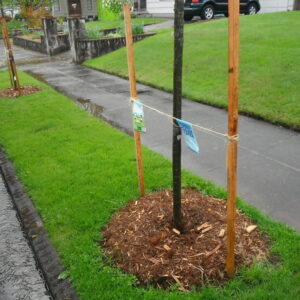Leaflet – Watching the Seasons Change

You’re not the only one who’s noticing that the days are getting shorter. Our trees are noticing, too, and they’re taking it as a sign that the growing season is over. How do they notice? A hormone response is triggered by the shorter daylight hours, the angle of the sun, the cooler temps. This past month, you may have noticed a spring-like flush of herbaceous growth on your trees—one final push before autumn. That new growth will harden into woody material tough enough to survive our first frost in November.
Leaves on some deciduous trees will start changing color, a welcome sign of the cooler seasons after an especially hot summer. In a process called abscission, trees reabsorb the nutrients stored in the leaves before detaching and shedding them. Chlorophyll, which gives leaves their green color, is one of the first things to be absorbed, which is why we see them change color. But fallen leaves still have plenty of nutrients, which is why we encourage you to leave the leaves. Trees are putting those leaves there on purpose, to enrich the soil for their roots.
Most deciduous trees shed leaves in the fall. Some don’t though! Scarlet oaks, swamp white oaks, and many evergreens shed leaves in the spring as new growth emerges
For now, the best thing we can do is watch the weather, just like our trees are. Continue your watering regime until we’ve had one inch of rain in a week. After that, we’ll be out of the dry season and beyond the growing season when trees actively expand their canopies as they photosynthesize. And it happens to coincide with the timing for our trees to transition into winter dormancy, when their sap returns to their roots.

Roots can grow year round in the right conditions—moisture, air, and temperature—which is why we plant when we do, so trees can focus on establishing their roots. To help keep those conditions right for your young tree, make sure you replenish your mulch in the next couple months. One inch of mulch is a windbreaker, three inches is like a down jacket – and we want that year round, protecting against temperature extremes. Tree roots can grow 365 days a year as long as they have some moisture and a moderate soil temperature, both things that mulch provide.
This time of transition can be really exciting. It’s always remarkable to feel like summer is barely over, but by Halloween, which is now right around the corner, most of our trees will be dormant. As the seasons change, so do the needs of our young trees. So watch the weather, and stay tuned to Treemail for best practices for each season!
